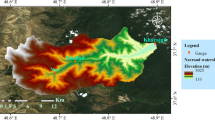Abstract
The suspended sediment load (SSL) modeling generated within a catchment is a significant issue in the environmental and water resources planning and management of watersheds. The estimation methods of SSL are limited by the important parameters and boundary conditions (which are based on the flow and sediment properties). In this situation, soft computing approaches have proven to be an efficient tool in modelling the sediment load of rivers. In this study, the hybrid Wavelet-M5 model was introduced to model SSL of two different rivers (Lighvanchai and Upper Rio Grande) at both daily and monthly scales. In this way, first, the runoff and suspended sediment load time series were decomposed using the wavelet transform to several sub-time series to handle the non-stationary of the runoff and sediment time series. Then, the obtained sub-series were applied to M5 model tree as inputs. The obtained results for the Upper Rio Grande River at daily time scale, showed the better performance of Wavelet-M5 model in comparison with individual Artificial Neural Network (ANN) and M5 models so that the obtained Nash-Sutcliffe efficiency (NSE) was 0.94 by the hybrid Wavelet-M5 model while it was calculated as 0.89 and 0.77 by Wavelet-ANN (WANN) and M5 tree models, respectively. Also, the obtained NSE for the Lighvanchai River at monthly time scale was 0.90 by the hybrid Wavelet-M5 model while it was calculated as 0.78 and 0.69 by Wavelet-ANN (WANN) and M5 tree models in the verification step, respectively.




Similar content being viewed by others
References
Addison PS, Murrary KB, Watson JN (2001) Wavelet transform analysis of open channel wake flows. J Eng Mech 127(1):58–70
ALP, M., Cigizoglu & H.K (2007) Suspended sediment load simulation by two artificial neural network methods using hydrometeorological data. Environ Model Softw 22:2–13
Azad A, Karami H, Farzin S, Saeedian A, Kashi H, Sayyahi F (2018) Prediction of water quality parameters using ANFIS optimized by intelligence algorithms (case study: Gorganrood River). KSCE J Civ Eng 22(7):2206–2213
Bhattacharya B, Solomatine DP (2006) Machine learning in sedimentation modelling. Neural Netw 19(2):208–214
Belayneh A, Adamowski J, Khalil B, Ozga-Zielinski B (2014) Long-term SPI drought forecasting in the Awash River basin in Ethiopia using wavelet neural networks and wavelet support vector regression models. J Hydrol 508:418–429
Goyal MK (2014) Modeling of sediment yield prediction using M5 model tree algorithm and wavelet regression. Water Resour Manag 28(7):1991–2003
Kuo CC, Gan TY, Yu PS (2010) Wavelet analysis on the variability, teleconnectivity and predictability of the seasonal rainfall of Taiwan. Mon Weather Rev 138(1):162–175
Mustafa MR, Rezaur RB, Saiedi S, Isa MH (2012) River suspended sediment prediction using various multilayer perceptron neural network training algorithms-a case study in Malaysia. Water Resour Manag 26:1879–1897
Nourani V, Davanlou Tajbakhsh A, Molajou A (2018a) Data mining based on wavelet and decision tree for rainfall-runoff simulation. Hydrol Res. https://doi.org/10.2166/nh.2018.049
Nourani V, Razzaghzadeh Z, Hosseini Baghanam A, Molajou A (2018b) ANN-based statistical downscaling of climatic parameters using decision tree predictor screening method. Theor Appl Climatol. https://doi.org/10.1007/s00704-018-2686-z
Partal T, Cigizoglu HK (2008) Estimation and forecasting of daily suspended sediment data using wavelet–neural networks. J Hydrol 358:317–331
Quinlan JR (1992) Learning with continuous classes. Proceedings of Australian joint conference on Artif Intell, 343–348
Salas JD, Delleur JW, Yevjevich VM, Lane WL (1980) Applied modeling of hydrologic time series, Water Resource Publications. Water Resources Publication, Littleton
Salimi A, Karami H, Farzin S, Hassanvand M, Azad A, Kisi O (2018) Design of water supply system from rivers using artificial intelligence to model water hammer. ISH J Hydraul Eng. https://doi.org/10.1080/09715010.2018.1465366
Senthil Kumar A, Ojha C, Goyal MK, Singh R, Swamee P (2011) Modeling of suspended sediment concentration at Kasol in India using ANN, fuzzy logic, and decision tree algorithms. J Hydrol Eng 17(3):394–404
Sharghi E, Nourani V, Molajou A, Najafi H (2018a) Conjunction of emotional ann (eann) and wavelet transform for rainfall-runoff modeling. J Hydroinf. https://doi.org/10.2166/hydro.2018.054
Sharghi E, Nourani V, Najafi H, Molajou A (2018b) Emotional ANN (EANN) and Wavelet-ANN (WANN) approaches for markovian and seasonal based modeling of rainfall-runoff process. Water Resour Manag 32(10):3441–3456
Shiri J, Kisi O (2010) Short-term and long-term streamflow forecasting using a wavelet and neuro-fuzzy conjunction model. J Hydrol 394:486–493
Singer MB, Dunne T (2001) Identifying eroding and depositional reaches of valley by analysis of suspended sediment transport in the Sacramento River, California. Water Resour Res 37:3371–3381
Sivakumar B, Wallender WW (2005) Predictability of river flow and suspended sediment transport in the Mississippi River basin: a non-linear deterministic approach. Earth Surf Process Landf 30:665–677. https://doi.org/10.1002/esp.1167
Solomatine DP, Xue Y (2004) M5 model trees and neural networks: application to flood forecasting in the upper reach of the Huai River in China. J Hydrol Eng 9(6):491–501. https://doi.org/10.1061/(ASCE)1084-0699(2004)9:6(491)
Yang CT, Marsooli R, Aalami MT (2009) Evaluation of total load sediment transport formulas using ANN. Int J Sedim Res 24(3):274–286
Author information
Authors and Affiliations
Corresponding author
Additional information
Publisher’s Note
Springer Nature remains neutral with regard to jurisdictional claims in published maps and institutional affiliations.
Rights and permissions
About this article
Cite this article
Nourani, V., Molajou, A., Tajbakhsh, A.D. et al. A Wavelet Based Data Mining Technique for Suspended Sediment Load Modeling. Water Resour Manage 33, 1769–1784 (2019). https://doi.org/10.1007/s11269-019-02216-9
Received:
Accepted:
Published:
Issue Date:
DOI: https://doi.org/10.1007/s11269-019-02216-9




